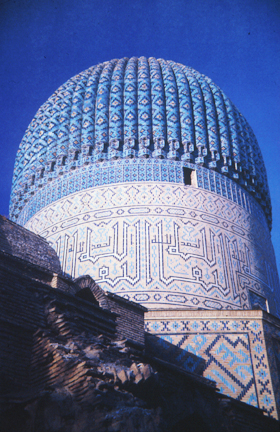Known in the West as Tamerlane, Timur was a particularly ferocious Central Asian warlord, who in the 14th century conquered much of what is today the Middle East, Turkey, Central Asia, and India. He declared himself a 'pious Muslim' and proclaimed his royal descent from Jenghis Khan, without any evidence to prove this claim. Few were willing to challenge him as he was known to be ruthless with enemies. He was an avid chronicler of his own exploits, and commissioned the creation of the 'Zafarnama,' an illustrated book of his conquests amounting to an early use of propaganda. One of his military strategies was to demand huge ransoms from cities in order to avoid their destruction. Those cities that refused to meet his demands would be sacked and the inhabitants slaughtered. Only the very young (under 5) were spared along with religious clerics and skilled artisans. The best craftsmen from his conquered lands were taken to his capital at Samarkand to work on his grand projects.
Perhaps the most famous of these projects was the Masjid-i-Jami, or what is known as the Friday Mosque. Built of colossal proportions, and made of fired clay brick and stone columns covered with multi-colored glazed brick and tile, the mosque can be seen glittering in the dazzling light of the sun from far away. The Friday Mosque has been partially restored to its original grandeur. It was through the construction of elaborate buildings such as this that Timur sought to define himself as a ruler of unparalleled power and renown. His court at Samarkand was known throughout the region as a seat of luxury and etiquette so exquisite the attendants stood by at the ready to enforce any breaches in decorum by visiting dignitaries.
This tradition of using glaze tile and brick can be traced directly back to its use in the ancient of Babylon, for example the Ishtar Gate. Timur was reportedly very involved in the design and construction of the mosque. No sooner that it was completed, he found fault with the height of the entrance gateway, saying it was too small. He had it torn down and rebuilt to larger proportions, overseeing the design and construction himself. The Dome, seen here, is covered with glazed tile mosaic and the section below is composed of glazed brick alternating with unglazed brick to create a very stylized inscription in Kufic from the Koran. This inscription is visible in the middle section of the dome wall. This technique of interlocking glazed and unglazed brick facade is called Banna'i. The lower section is also done in banna'i, but here the design is clearly related to patterns seen in carpet and textile design.
In addition to the Friday Mosque, Timur was responsible for the construction of many other buildings at Samarkand, including his family mausoleum, the Gur-i-Amir complex. Timur was preparing to invade China in 1405 when he died.

Dome of the Masjid-i-Jami (Friday Mosque), built by Tamerlane (Timur the Lame), Samarkand, 1398-1405 CE, Glazed Tile and Brick


